For Indonesia bahasa version of this report click here
I HAVE been one of the most enthusiastic supporters of breeding cattle in palm plantations since I first saw this type of operation in Malaysia in the 1980s.
A number of Indonesian palm plantation companies have conducted trials over recent years with mostly positive results in terms of production but with marginal financial returns.
In order to breed cattle in numbers large enough to provide a useful impact on self-sufficiency in Indonesia, the returns need to be very attractive and unfortunately, while they are generally positive, I don’t believe profit margins are high enough to encourage large scale adoption of the breeders under palm model.
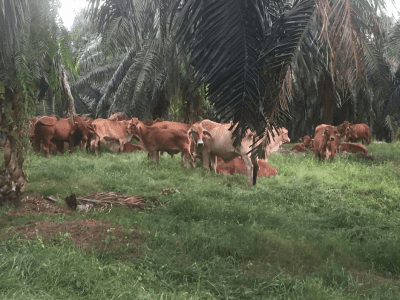
Breeders under palms can do well with good management but the profit margins are simply not high enough to attract a large number of big investors.
Recent changes in beef processing throughout rural Indonesia now make it possible to consider a new palm grazing model that has the potential for high levels of productivity and profitability.
Firstly, while the national cattle herd is static or possibly even slowly expanding, the number of slaughter males available for normal wet market beef supplies is shrinking as a result of the rapid increase in the numbers of bulls (there are no steers in Indonesia) slaughtered for the annual Qurban religious festival.
Official government figures for 2019 show that over the three-day Qurban festival last August, 541,171 bulls were slaughtered across Indonesia. Given reporting difficulties in some areas this could easily be well below the real figure. Hence the number of male slaughter cattle available for normal domestic market supplies for the rest of the year is seriously reduced placing upward pressure on prices. The law prohibiting the slaughter of breeding females is strictly enforced. This supply gap is partially being filled by imported Australian cattle which are fattened in local feedlots then slaughtered in ESCAS approved abattoirs (Export Supply Chain Assurance System – the Australian animal welfare monitoring system) which have been established far and wide across Java, Sumatera and Kalimantan.
Imported Australian cattle are now able to be slaughtered under ESCAS requirements in locations never before considered as commercial. The management of feeders grazing in the plantation needs to have ESCAS compliance but this should not be difficult to manage as animals are seen every day as they move to a fresh grazing area allowing for accurate traceability as well as a high standard of welfare and husbandry. Fattening Australian feeder steers in palm plantations in remote areas of Sumatera and Kalimantan has suddenly become a feasible option.
The key parameters that suggest that grazing steers is potentially profitable include :-
- Average daily gains (ADG) of 330 grams per head per day are known to be easily achieved by cows and growers grazing under palms so in 3 days a steer should be able to gain 1 kg (or more).
- The total cost per head per day including all inputs for breeding cows is about Rp10,000 so it might cost up to 3 x 10k = Rp30,000 to gain 1 kg of live weight. Operational costs for steers will certainly be less.
- Switching from breeders to steers means that mating, abortions, calving difficulties, cow infertility, calf mortality, heifer segregation, mis-mothering, weaning, bulls fertility, pregnancy testing, etc. etc. all disappear from the management package. Average mortality rates of steers grazing pasture will always be much lower than that of breeders.
- For slaughter animals, the value per kg live weight in Kalimantan and Sumatera where virtually all the palm plantations are located is around Rp45,000 (Rp50,000 in some areas) which means that there appears to be a profit margin of around Rp5,000 per head per day
- Feeder steers arrive in Indonesia at an average of about 320 kg. After growing for 1 year at 330 gm per day they will have gained about 120 kg so they will then be about 440kg live weight.
- If the net profit is Rp5,000 per day then the annual profit per head is Rp1.825 million or AUD$198 (AUD$1 = Rp9,200).
- If an easily manageable group of 250 steers can be grazed together then the annual net return for the unit should be about Rp456 million (AUD$49,500).
- With the average plantation size about 5,000 hectares and a conservative stocking rate of one steer for 5 hectares this means that an average plantation might be able to graze up to 4 groups of 250 head with an annual net return of close to AUD$200,000.
- Marketing should not present a great challenge as animals can be sold throughout the year, as required in small truck lots into hungry local markets. A 1,000 head steer grazing operation would need to sell an average of less than 3 head per day.
- From conception to sale of a grown progeny can take close to 3 years for a breeder project while purchase of a feeder to sale of a fat steer will be nearer to 12 months or less.
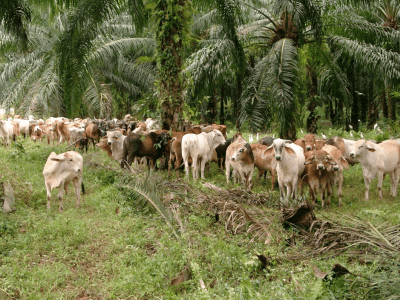
Growers grazing under palm. Minimal management with scope to speed up performance by increasing cost effective supplementation.
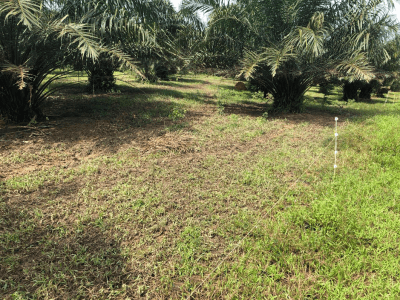
this is yesterday’s cell after a single day of grazing. Woody weeds will be spot sprayed in the next few days. These trees are about 5 years old. The cattle will cycle back to this cell in about 70-90 days time.
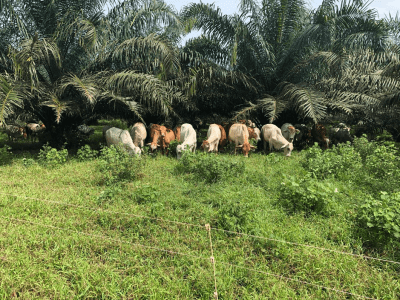
Feeders grazing the next cell the day after the photo above. This mixed group of male and female yearling progeny from imported Australian cows are growing at 600 grams per head per day with a modest level of daily supplement.
If an imported feeder steer grows at 500 grams per day then in 2 days it gains 1kg or a value of Rp45,000. Deduct costs of 2 x Rp10,000 leaving a profit margin of Rp25,000 in 2 days. Rp12,500 per day or AUD $1.35 per day x 365 = AUD$492 per year or $123,000 per year for a single 250 head grazing group. Now we’re talking. But remember this level of performance will only be possible in a very well managed plantation with well established grazing conditions. This quantity and quality of grass is usually only possible to develop after 2 or 3 years of effective cell grazing and spot spraying of woody weeds.
One of the main concerns of plantation owners grazing cattle is that their stock would be at risk of theft as they would be out in the plantation overnight where thieves would have the opportunity to steal them. Data collected over the last 3 years in projects where breeders grazed under palms in remote areas of Sumatera and Kalimantan demonstrate that while this certainly is a possible risk factor, the actual experience in the field shows that this risk is an extremely small and acceptable one. The costs of effective levels of security are included in the Rp10k per day total cost for breeders.
Admittedly this model doesn’t solve the breeding shortages in Indonesia and still requires imports but it does provide additional fresh beef supplies with local value adding in remote areas and has potential to cut the costs of herbicides for palm plantations. While small holders won’t be directly involved in the management of the cattle, it is possible to include them in the project by operating a nucleus-plasma model where local small holder groups could be financed into ownership of a proportion of the stock while the plantation company manages the grazing operation and shares the profit. The welfare challenges for steers are insignificant compared to those of breeders.
As the demand for bulls purchased specifically for the Qurban religious festival rises along with the income levels of Indonesian citizens, the numbers of locally bred slaughter bulls available for normal daily supplies of fresh beef will continue to shrink.
This palm feeder steer option has the potential so solve many if not all of the Indonesian government’s fresh beef supply problems in its more remote areas with a model that is profitable, where small holders can share in those profits and where animal welfare and security risks are minimised.
In the first instance, while the plantation companies unfamiliar with cattle management figure out how best to conduct operations, an opportunity exists for Australian producers and exporters to provide support, training and potentially commercial participation in the business.
Northern Australian cattle producers have a life-time of experience grazing cattle in remote areas and may well enjoy seeing feeder cattle facing up to fresh green feed every day of the year.


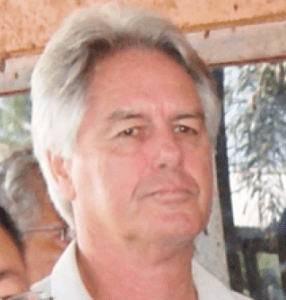


Ross,
what sort of palm trees are these? Are these the palm plantations that replaced the hardwood forests where I got the timber for the deck around my pool. What is the carbon budget look like for this proposal? I was presenting a similar initiative the other day to a room of people and some non-farmer type completely wiped my creditability out the door when I wasn’t able to answer that tricky question.
Gday David, yes these are the oil palm trees that have largely replaced the natural tropical forests of Indonesia.
Short answer is I don’t know the answer to your question on carbon. What I do know is that these palm plantations are a reality now with about 15 million hectares in Malaysia and Indonesia combined. The tropical forests are gone. This is not a matter of do we cut down more forests but do we utilize the opportunity for efficient beef production from the existing system. Using cattle as lawn mowers also results in a significant reduction in the use of herbicides for weed control in plantations so if we dont graze cattle then the environment is not improved. regards. Ross